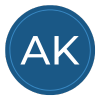Context & Problem
This study was a part of my MBA in UX Design & Strategy and with it a proposal was created to be presented to companies which want to be more Diverse & Inclusive to the LGBTQIA+ population, considering not only the design aspects but also the business.
Despite the growth of this population and the expressiveness of its financial power, prejudice in the labor market is still a reality. According to a survey made by G1 portal in 2015, 11% of recruiters said they would not hire homosexual professionals for executive positions and 7% would not hire homosexual professionals at all. Thus, it is not surprising that 61% of Brazilian LGBT professionals do not assume their sexuality at the workplace.
Diversity in the work environment is still a challenge, but the investment pays off. The Diversity Matters study, conducted with companies in Latin America, reports that companies committed to diversity are up to 1.5 times more likely to have happier employees, who also want to stay longer and reach higher levels in the organization (McKinsey, 2020). According to GPTW data, there are twice as many LGBTQIA+ people at all levels in awarded companies than in non-awarded ones (GPTW, 2022).
Process
To start this work, me and my group made a desk research to have some ideas about what exists in the market regarding this kind of initiative, including the Total Addressable Market (TAM).
Five players were analyzed and some features common to all of them were identified. On the other hand, some functionalities were not identified in any of the platforms, and this is the differential of this solution.
In addition to the previously analyzed players, sites where the focus is exclusively related to vacancies with the LGTBQIA+ cause were also considered. We carefully analyzed the existing products, including the user journey whenever it was possible and from this, a comparative matrix was done which was a base for us to start build our personas (a research plan was done), value map and the business and value proposition model canvas.
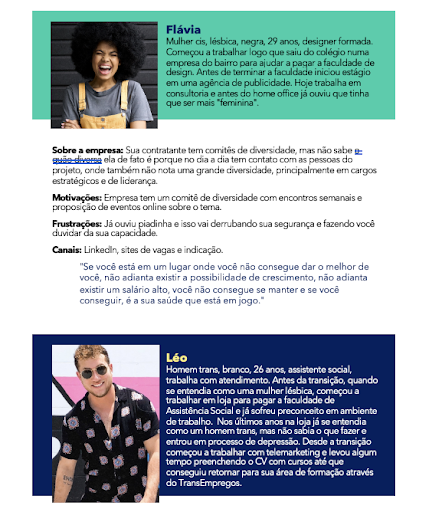
Some of our personas.
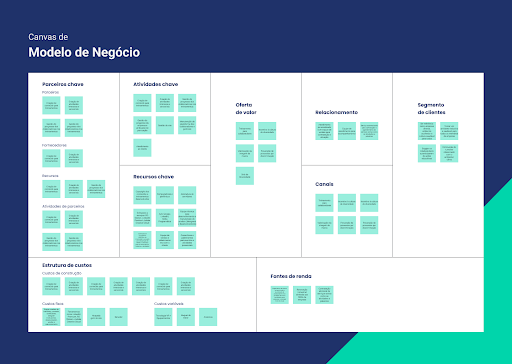

Canvas: Business model and Value proposition.
A validation of the idea with real potential customers was made: a survey carried out in December 2021 with 26 HR managers, we sought to understand what is the vision of diversity in their companies and what is the perspective on this subject. We understand that this survey had a very low sample for validating our value proposition and business model and we held a conversation six months later with 11 more professionals to complement it with a more qualitative look.
Overall, it can be said that half of the professionals who responded to the 2021 survey consider their diverse workforce and culture of diversity to be good to great. It would be important to have an understanding of the opinion of the employees themselves about this, but we think it is worth understanding from the perspective of those who would seek the service. Half of these companies have as their main initiative the creation of diversity committees, which would be a great gateway to a service like ours, being a good opportunity.
From the validation, we started the economic validations to establish if the solution/business would really survive. Fixed and variable costs, business building expenses, sales projection, product/service unit pricing were considered in the calculations.

Example of one of the economic analysis perspective.
Once the idea and the economic scenario were validated, we started one study considering user journeys, task and flows, prototypes, and validations with potential users by usability tests were made. It was a significant part of the process and we had many discussions around this study. Also, the Marketing to build the logo, moto and define the colors as well an extensive UI work were done.

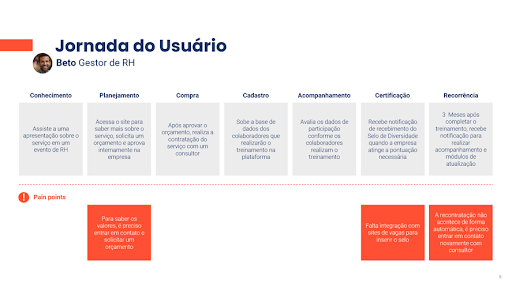


Examples of one of the flows, journey map and the entire blueprint.
Solution
Even with existing solutions on the market, it can still be difficult for LGBTQIA+ professionals to know if the companies where they will work really have a welcoming and inclusive culture. Seu Lugar appears to meet this demand, being the first complete track of diversity training for the entire team, with certification recognized and respected in the market in the form of a Seal of Diversity awarded to companies that reach the required score in training. In addition, all training is designed to generate engagement, with interactive content, knowledge tests and gamification strategies.
Our audience is small, medium and large companies, in all areas of activity. For MVP, at first our focus was on companies headquartered in São Paulo. Our communication would be aimed at HR managers and other C-level positions, as they are the ones who have the purchasing decision power. To reach them, we would rely on advertisements on social networks (mainly LinkedIn), participation in HR events, sending educational materials (ebooks) to capture leads, and word of mouth.
Seu Lugar is the ideal solution for companies that wish to increase the culture of diversity in their teams, either because they have already received complaints of prejudice and homophobia, because they have a high turnover of LGBTQIA+ employees, because they suffer pressure from the public opinion (and even boycotts) due to episodes of discrimination, or because they have diversity goals to meet. It is also ideal for companies that already have a training program, but encounter resistance from employees, since Seu Lugar’s trails are fun, interactive and rely on gamification techniques to increase engagement.
Trails and logins were designed for different company profiles, and the Software as a Service (Saas) model was adopted, due to the nature of this type of service and aspects based on studies involving scalability, for example.
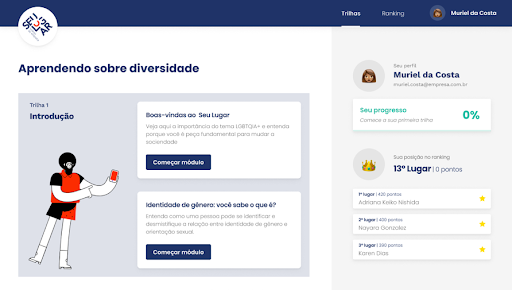
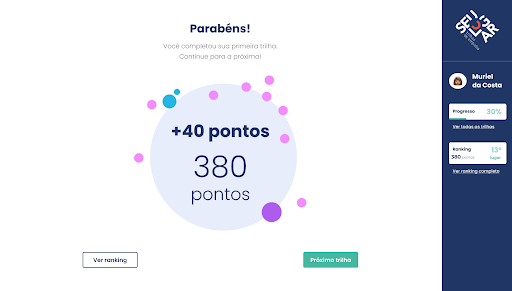
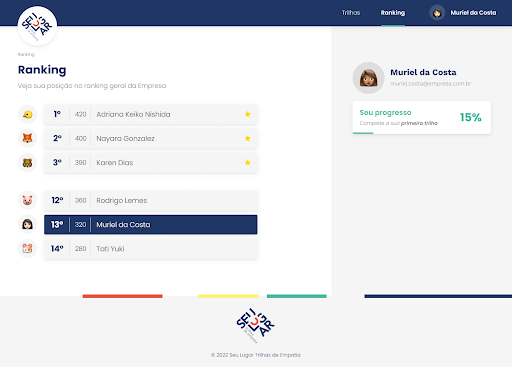

Screens of the solution.
Results & Impact
In the proposed scenario, we would offer a B2B subscription service, with different price ranges depending on the size of the company. We encourage annual renewal to keep the diversity seal active and update the content.
With conservative projections, we expected to reach an average of 169 monthly subscriptions in the first year of operation, reaching the break even in year 3 and reaching significant revenue in year 5 – which represents only 0.47% of the potential market. Values detailing are hidden because of the study strategy.
In addition to the Break-even, another point of attractive analysis is the Internal Rate of Return (IRR), in which allows to compare how much was invested with the gains in present value. The IRR, essentially, helps investors to decide whether or not the investment is worth receiving their respective contributions. It is compared with the expected return rate from the investor. In our case, it was considered an attractive investment after this analysis.
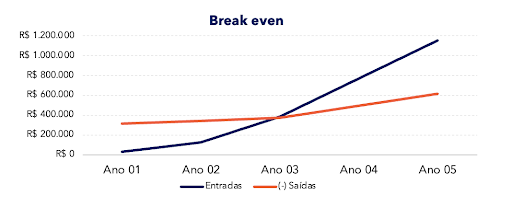
Our break-even.
